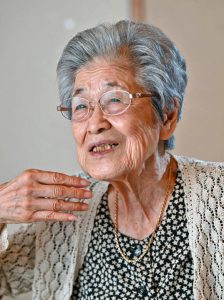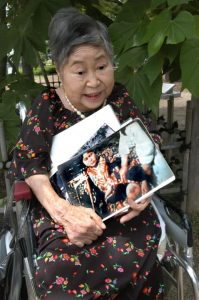My guidepost, Hiroshima pioneers: Megumi Shinoda, 92, A-bomb survivor who communicates her experience to public, speaks about Suzuko Numata
Nov. 25, 2024
Dedicated her life to continually speaking about experience in atomic bombing
by Kyoko Niiyama, Staff Writer
Around 15 years ago, when she was in her late 70s, Megumi Shinoda was finally able to openly communicate to others about her experience in the atomic bombing, which she had experienced at the age of 13. At the time of the bombing, she was a second-year student at Hiroshima Girls’ Commercial School (present-day Hiroshima Shoyo High School). She had kept quiet about her experience for a long time due to a “sense of guilt” she carried around because of her escape from death in the bombing. That day, she had not participated in building-demolition work for the creation of fire lanes in the central part of Hiroshima City.
She began to share her experiences with younger generations because a mentor of hers provided her with a supportive push. The mentor’s name was Suzuko Numata (who died in 2011 at the age of 87), an A-bomb survivor who continued to testify underneath an A-bombed Chinese parasol tree in Peace Memorial Park (in Hiroshima’s Naka-ku) about her experience in the atomic bombing to students visiting the park on school trips.
The two became acquaintances five years after the bombing, when Ms. Shinoda was a second-year student at Yasuda Girls’ High School, where she had re-enrolled. She took a home economics class from Ms. Numata, who then taught at the school. They became closer through knitting, a hobby enjoyed by both. Ms. Shinoda was also invited to Ms. Numata’s house, which she shared with many cats.
Ms. Shinoda said, “Since she was always cheerful and smiling, I never imagined at the time that Ms. Numata had experienced despair because of the war.” Many years later, when her former teacher began to live in a nursing-care facility at the end of her life, she had the opportunity to listen to details of Ms. Numata’s horrific experience in the atomic bombing.
Ms. Numata, 22 at the time of the bombing, was at her workplace in the Hiroshima Communications Bureau (in Hiroshima’s present-day Naka Ward), located around 1.3 kilometers from the hypocenter. She became trapped under the building and had to have her left leg amputated. Her fiancée died in the war. She was unable to have any hope for her life after the war’s end, but she ultimately chose to live on, encouraged by the Chinese parasol tree that had survived the atomic bombing and put forth new buds.
Ms. Numata started publicly testifying about her experience in the atomic bombing nearly 40 years after the bombing. Her life course was altered by the 10 Feet Film Project, a campaign in which Hiroshima citizens, starting in the early 1980s, gradually purchased film footage pertaining to the atomic bombing that had been shot by the U.S. Strategic Bombing Survey team, and from that produced a documentary film. After appearing in that documentary titled “Ningen wo Kaese” (in English, ‘Bring back the humans’), released in 1982, she began to participate in screenings in Western nations, determining then to speak about the reality of the devastation wrought by the atomic bombings. She was also engaged in the founding of Hiroshima wo Kataru-kai (a group of members speaking about Hiroshima), made up of survivors willing to share their A-bombing experiences.
Based on the idea that “peace will never be created from hearts full of hate,” she conveyed how she had overcome suffering and confronted the issue of Japan’s responsibility for inflicting damage in Asian nations during the war. She dedicated herself to the work of promoting communication with people in Southeast Asia and China as head of a civic group called the Hiroshima Asian Friendship Association. In addition, placing her wishes for peace in the A-bombed Chinese parasol tree from which she had once gained hope, she continued to distribute seeds from the tree to others.
Ms. Shinoda said, “She committed her life to communicating her experience in Hiroshima and about the absurdity of war.” Impressed by her teacher’s dedication, Ms. Shinoda supported Ms. Numata’s testimony activities by helping her prepare materials, among other work. When Ms. Numata was scheduled to share her story with visitors on school trips four times on one day, Ms. Shinoda, worried about her health, asked her to “simply refuse” the requests. Never relenting, Ms. Numata said, “I don’t have much time left.” Ms. Shinoda said, “I felt her strong conviction.”
One day, when Ms. Shinoda was working to support her former teacher at her side, she was requested by a civic group “to tell us about your own experience in the atomic bombing.” It was memory she had sealed off for a long time. As she wondered whether to accept the request, Ms. Numata said to her, “You can simply talk about what you saw at the time. We have to ensure no one else will ever have the same experience I did.” In the belief that talking about the reality of the A-bomb devastation from her perspective would lead to a future in which no one other such survivors would be created, she decided to follow her teacher’s advice.
Ms. Shinoda began to speak about her experience in the atomic bombing in her late 70s, and was appointed by the Hiroshima City government to serve as one of the official A-bomb survivors who share their A-bombing experiences when she was 85. She stepped down from that role earlier this year in the spring, but she continues to share her experience with young people upon request. Keeping in mind her former teacher, who dedicated her life to sharing her experience in the atomic bombing, Ms. Shinoda focuses all her energies.
Profile
Megumi Shinoda
Born in Hiroshima City, Ms. Shinoda’s maiden name was Sera. She experienced the atomic bombing at her home in the area of Oshiba-cho (in Hiroshima’s present-day Nishi Ward), losing her 17-year-old older sister and two-year-old younger brother. After graduating from Yasuda Girls’ High School, she worked as a kindergarten teacher and married when she was 22. She raised three children. In 2017, she was appointed by Hiroshima City to begin serving as an official A-bomb survivor sharing her experience, retiring from that role in the spring of this year. She now lives in Hiroshima’s Naka Ward.
Keywords
A-bombed Chinese parasol tree in Hiroshima
This tree was affected by the atomic bombing in a courtyard at the Hiroshima Communications Bureau, 1.3 kilometers from the hypocenter. Exposed to the A-bomb’s thermal rays and blast, the tree appeared close to death, but it sprouted new buds again the following spring. In 1973, the tree was transplanted to Peace Memorial Park, in conjunction with reconstruction of the Chugoku Postal Administration Office. Activities related to the tree continue today, including civic campaigns to send seeds picked from the tree to other sites throughout Japan, and a Hiroshima City government initiative to distribute seedlings grown from the seeds to schools whose students have visited Hiroshima on school trips.
(Originally published on November 25, 2024)









